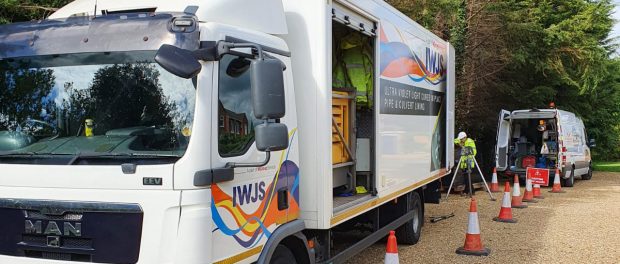IWJS Undertakes No Dig Structural Relining Works to Minimise Disruption on Cambridgeshire Culvert Project

IWJS, a part of M Group Services, has delivered structural renovation lining works to thirteen sections of culvert in Leverington, Cambridgeshire, on behalf of North Level District Internal Drainage Board (NLDIDB).
The NLDIDB is an area of the Fens that is largely reliant on pumped drainage to evacuate surplus water from agricultural, industrial and urban properties, discharging to adjacent main rivers.
The relining works in Leverington cover 421m of culvert, ranging in diameter from 600mm to 1,000mm. IWJS was appointed to deliver the works after detailed asset condition surveys highlighted structural and service defects throughout. The work undertaken will extend the life of the asset and ensure adequate drainage systems are maintained as part of a larger programme of culvert relining works that IWJS is delivering in Cambridgeshire on behalf of NLDIDB.
After initial camera and laser profiling surveys revealed that sections of the asset were larger in diameter than records indicated, the technical, structural design of the linings were amended to reflect the changes, internal hydraulic flows and external ground loading.
Environmentally compliant and safe working areas were established at each culvert entrance and mitigation measures included the use of temporary inflated dams and over pumping at the outfall position to remove water held and to manage flows in a safe and controlled way. Large diameter bungs, pumps and intermediate dams were also used to isolate individual sections and to control flows during the installation of the liners.
CCTV surveys were carried out before high pressure water jetting was used to clear each culvert of silt and debris. All parts of the overall culvert assets, including manhole sumps and the mouth of the outlet, were also desilted.
A robotic cutting unit was used to remove several intruding connections, eliminating any obstructions that would prevent or limit the lining installation. In total, 22.7 tonnes of silt and debris was removed from the assets.
Accessibility was a key engineering challenge throughout the works. To avoid the required specialist equipment causing disruption to local residents, the IWJS installation team manufactured and installed a bracing system designed to sit on the outside of the existing concrete headwall and hold a double roller system in place in order to aid the liner installation.
The bracing system enabled the large diameter lining to be winched into place a significant distance from the delivery vehicle which was positioned away from local properties to minimise disruption. This innovation behind this liner installation process proved to be a key factor in its success and achieving community satisfaction.
Once all structural liners were winched into place, inflated and cured using a fast UV process, the connections into the culverts were reopened using robotics, together with manholes that were lined through in the rear of properties for which vehicle access was not possible. The ends of the liners were trimmed post-lining, whilst CCTV surveys showed that all liners were successfully installed and cured, leaving the existing assets structurally sound and free flowing.
IWJS Managing Director, Christopher Stewart, commented: “IWJS provided a full solution throughout this project, from the initial detailed asset condition survey through to the design of the structural lining solution, the use of robotics to remove obstructions, the deployment of fast UV cure lining technique and the final commissioning. This was a complex project and we are delighted with the positive client feedback on our approach to renovating these culverts, whilst keeping disruption to the local community to a minimum.”

